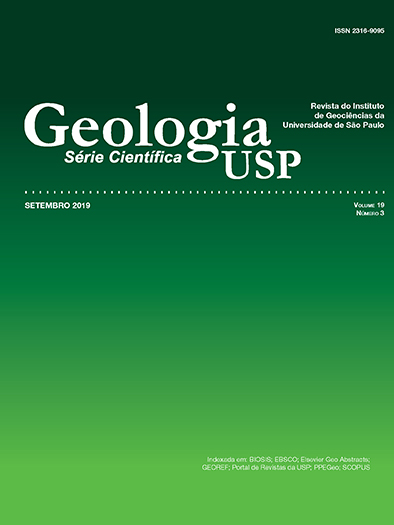Structural evolution of the Arroio Divisa Granitoids during the transcurrent movement of the Quitéria-Serra do Erval Shear Zone, Rio Grande do Sul
DOI:
https://doi.org/10.11606/issn.2316-9095.v19-140196Keywords:
Granitic magmatism, Syntectonic, Transcurrent shear zone, Syn-magmatic deformationAbstract
The Arroio Divisa Granitoids (ADG) comprise an association of predominantly granodioritic rocks, with minor dioritic and tonalitic varieties. They are medium- to coarse-grained rocks of heterogranular texture and foliated structure. Internal structures suggest their emplacement within a ductile transcurrent shear zone related to the Neoproterozoic Southern Brazilian Shear Belt. These rocks bear records of crystallization under stress deformation history and decreasing temperature conditions, which is outlined by the concordant overlapping of magmatic structures and those formed by solid-state deformation under high to low temperature. The distribution of structures within the intrusive body is heterogeneous, generating high- and low-strain zones formed in the magma and persisting throughout solid state. In the inner portions of the intrusion, there is predominance of flow structures where preferential shape orientation is dominant, and the internal deformation of markers is poorly developed. Toward the northern boundary of the intrusion, progressive increase of solid-state strain leads to the generation of a strong mylonitic foliation parallel to the magmatic fabric. High-temperature microstructural features include the development of the chessboard-pattern subgrains in quartz crystals and the generation of large subgrains in K‑feldspar and plagioclase crystals, both compatible with upper amphibolite facies temperature conditions, and with the solidus temperature of granitic compositions. Low-temperature microstructural features consist of bulging recrystallization in quartz, newly‑formed fine grains around feldspar crystals and the development of flame perthites on K-feldspar, which is compatible with greenschist facies temperature conditions, far below the solidus. Therefore, high-temperature microstructures would be associated to the initial stages of magma cooling and crystallization, whereas the lower-temperature ones would point to the post-crystallization stage, when the plutonic rock and its host achieve
Downloads
Downloads
Published
Issue
Section
License
Authors who publish in this journal shall comply with the following terms:
- Authors keep their copyright and grant to Geologia USP: Série Científica the right of first publication, with the paper under the Creative Commons BY-NC-SA license (summary of the license: https://creativecommons.org/licenses/by-nc-sa/4.0 | full text of the license: https://creativecommons.org/licenses/by-nc-sa/4.0/legalcode) that allows the non-commercial sharing of the paper and granting the proper copyrights of the first publication in this journal.
- Authors are authorized to take additional contracts separately, for non-exclusive distribution of the version of the paper published in this journal (publish in institutional repository or as a book chapter), granting the proper copyrights of first publication in this journal.
- Authors are allowed and encouraged to publish and distribute their paper online (in institutional repositories or their personal page) at any point before or during the editorial process, since this can generate productive changes as well as increase the impact and citation of the published paper (See The effect of Open Access and downloads on citation impact).





